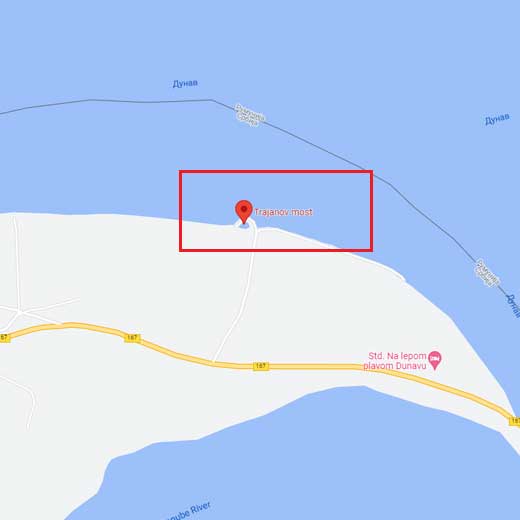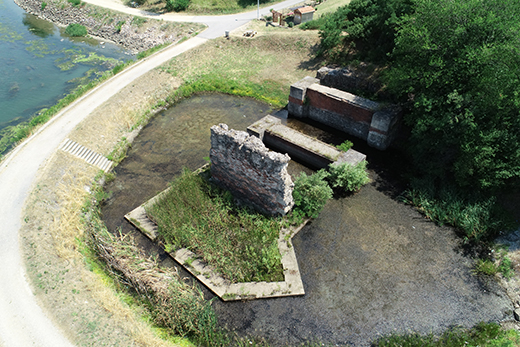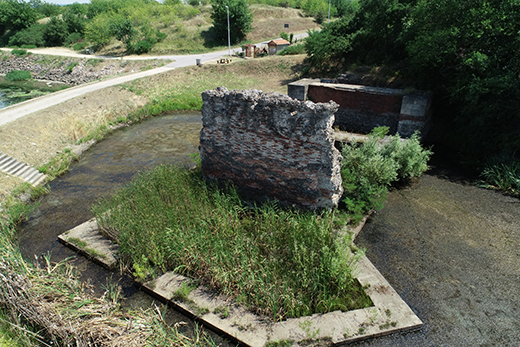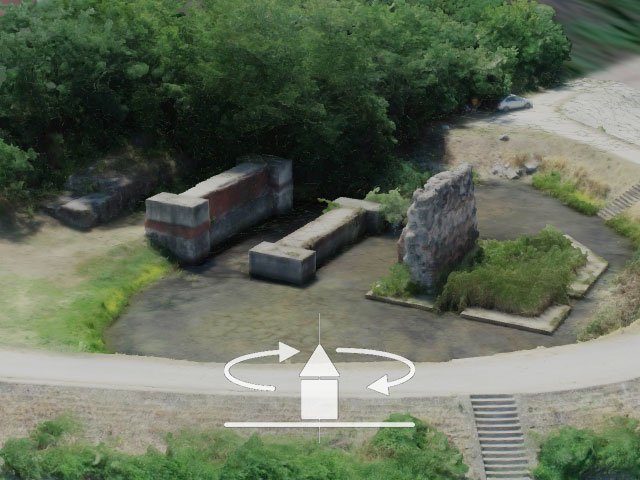Trajan's bridge - Castrum Pontes
Protected cultural monument of extraordinary significance, listed as AN 44 with the Republic Institute for the protection of monuments of cultural heritage.
Trajan's bridgeCastrum Pontes, Kladovo, Bor District
Where is it
The remains of Trajan’s bridge on the Danube and castrum Pontes are 5 kilometers downstream from Kladovo, near the village Kostol.
The place to build the bridge was determined by the natural characteristics of the terrain. The Danube was calm and shallow here and the river bed was sandy. Even today the mark is visible where the Danube was reverted in order to build the bridge on dry land.

Research
Trajan’s bridge used to be a world wonder. As late as 1856 some twenty-odd pillars could still be seen in the water bed. Since those pillars made sailing the Danube difficult, International Danube Committee decided in 1906 to destroy two pillars. In 1932 the remains of 16 pillars were located. Some fifty-odd years later, the water took four more pillars, leaving the total of 12.
Archaeological research and conservation work on former Trajan’s bridge have been performed since 1979, during the construction of the Hydro plant “Djerdap II”. Archaeological research of the castrum Pontes discovered the plan of the fortification and the layout of its ramparts and towers.
Underwater research of Trajan’s bridge was conducted in 2003 using modern technology and underwater cameras. The remains of the bridge were noted, and its definitive exact length was confirmed– 1097,5 meters.

History
Trajan’s bridge over the Danube was built in 103-105 AD, by the architect Apollodorus of Damascus from Syria. It connected Kostol on the right and Drobeta-Turnu Severin on the left bank of the Danube.
The bridge was part of the preparations for the second Dacian war and final conquering of the province of Dacia, today’s Romania. One year after the completion of the bridge, the emperor Trajan defeated the Dacian king Decebalus, making Dacia a Roman province. The loot they took with them to Rome was 331 tons of silver and 165 tons of gold. The Romans celebrated for 123 days.
Although Trajan’s bridge had been the longest built bridge for over a thousand of years, it was not used for a long time. One version says that it was destroyed by Trajan’s successor Hadrian (117-138 AD), the second, less likely one, that it collapsed after some twenty years, and the third that it was destroyed by the emperor Aurelius (270-275 AD) after losing Dacia as a province.
During the construction of the bridge, for the purposes of its defence, military castra were erected, Pontes on the right and Drobeta on the left river bank. Castrum Pontes was almost square in shape and had an important function on the Danubian limes.
During the X century, on the location of the castrum, a medieval settlement was formed, next to which there was a necropolis.

Description
In the village of Kostol four pillars of the former bridge are preserved, connected with arches. In order to be protected from the Danube’s high water level, the remains of the pillars are protected with an embankment. These pillars show the way they were built, using bricks and stone blocks.
The total length of the bridge with the portals was 1133,90 meters, and the part that was above the river bed was 1071 meters. The width was 14,5 meters. There used to be 20 pillars inside the river bed, at 56,5 m apart. The pillars’ dimensions were 18-19 х 33-34 m. The foundations of the pillars were made of hard lime mortar and built of brick and ashlar. For the fortification purposes, the pillars had wooden armatures.
The Ministry of culture of the Republic of Serbia has a project that plans to make a hologram in the place of the former bridge so that the visitors could see what it used to look like over the river.
Folk lore and belief
The folk tale “Emperor Trojan has Goat’s Ears!” can possibly be linked to the emperor Trajan. During his reign, Trajan established the system of customs and taxes and began the exploitation of ore wealth in the provinces. He forged coins with his own face and had sculptures of himself made, which made some historians conclude that he was a self-centred person. The defeated Illyric tribes had to pay taxes and be recruited to fight in the Roman army, so it may be possible that the story of the emperor with goat’s ears was fabricated as some sort of revenge.
Julka Kuzmanović Cvetkovićarcheologist
